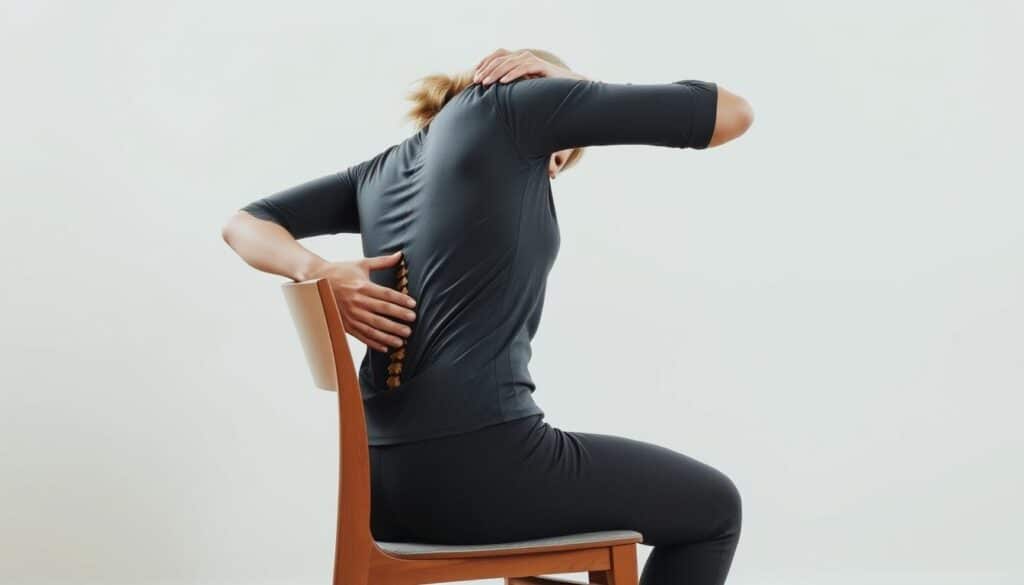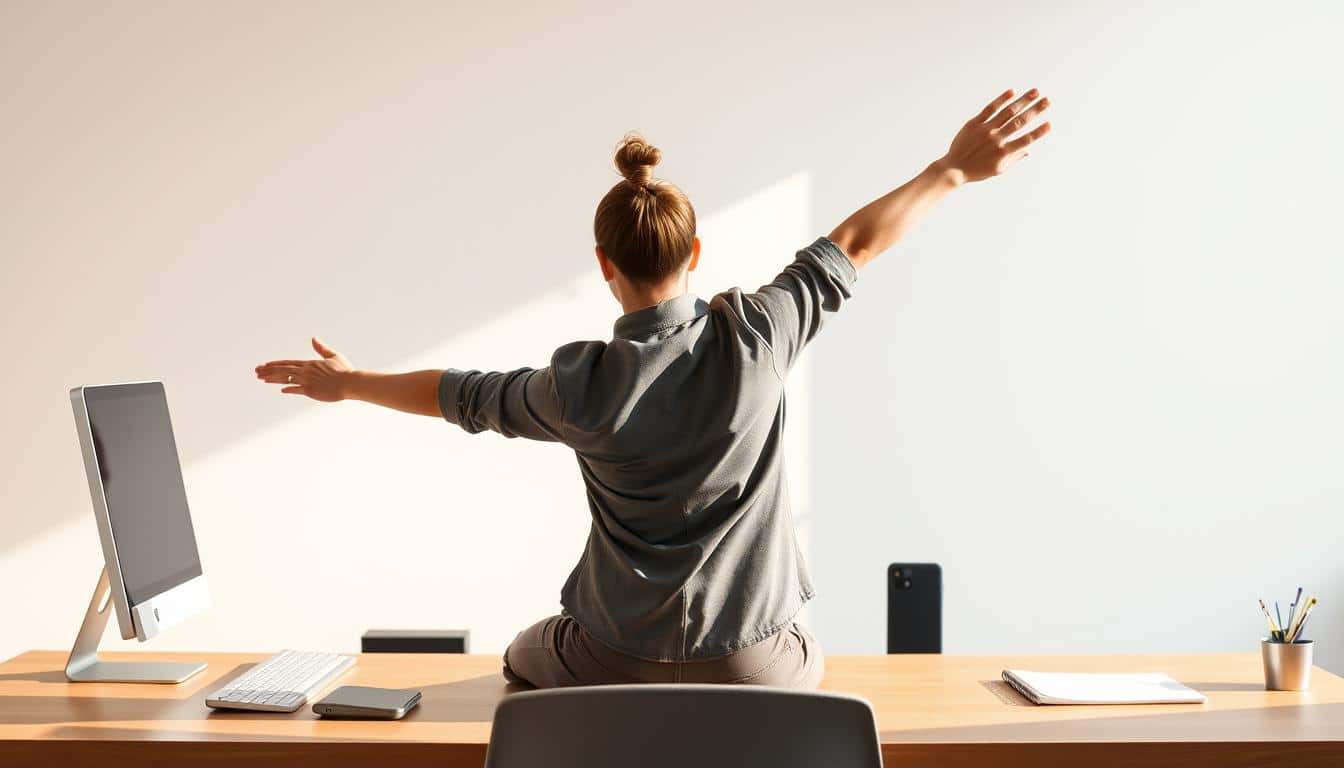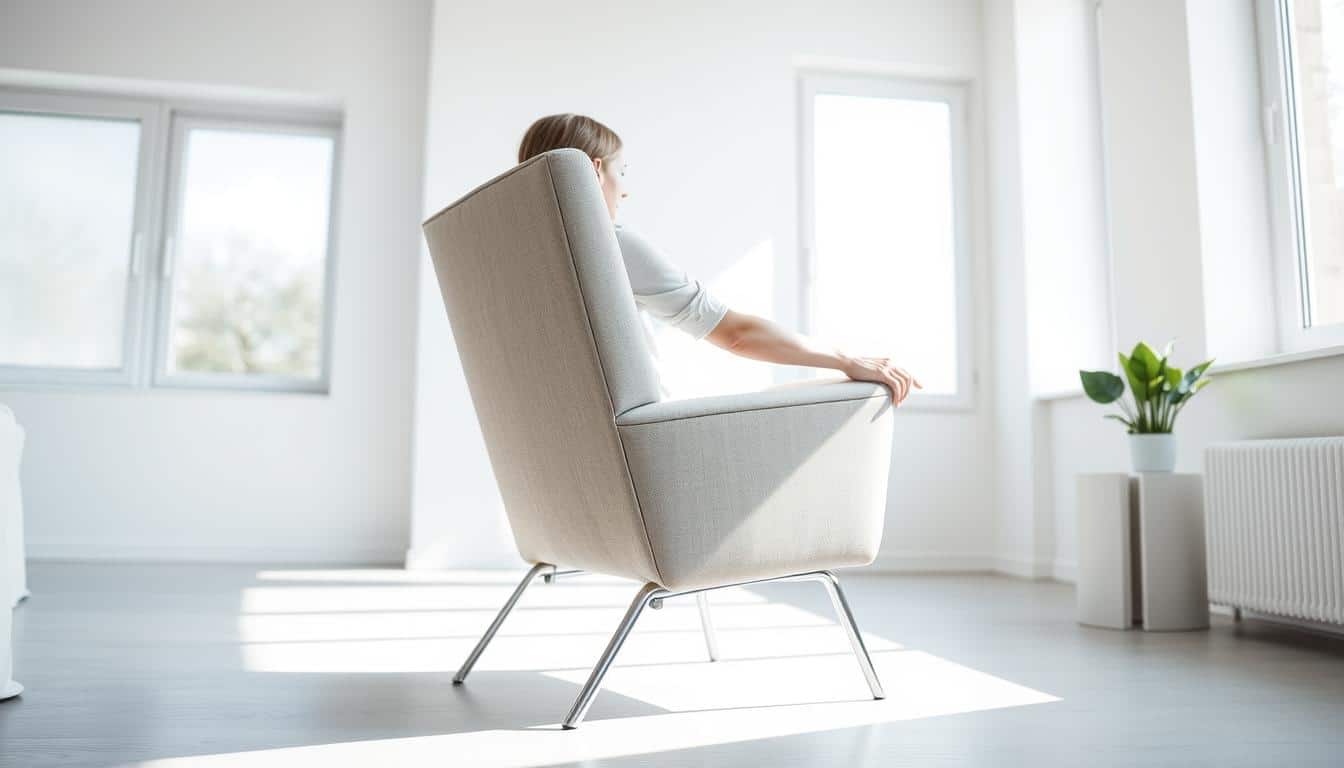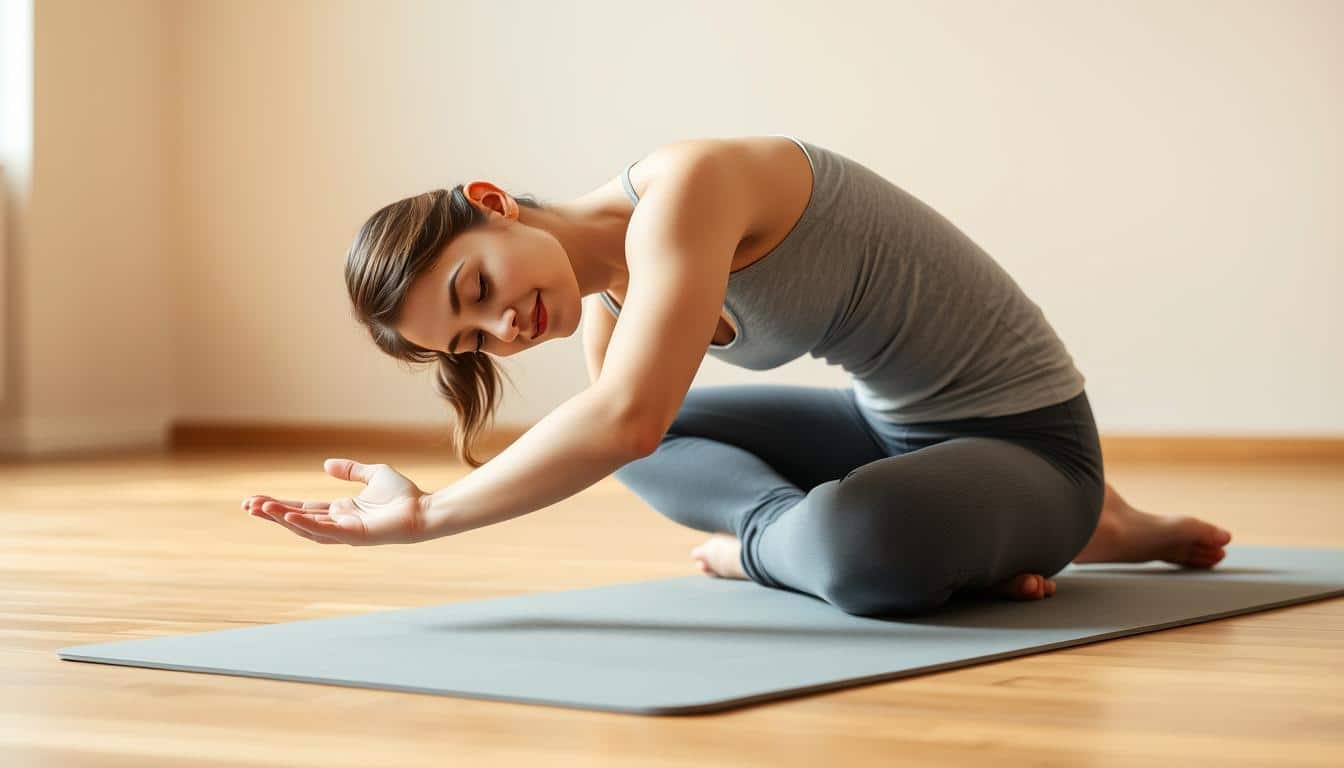Anúncios
Many people in the United States spend long hours seated at desks, caregiving stations, or on the couch. This guide shows simple, practical chair stretching you can use anywhere to combat inactivity and reclaim comfort.
Chair stretching routines are low-impact and require no equipment. They help improve circulation, ease neck and back tension, reduce leg swelling, and boost posture and energy. Whether you work at Google, a local hospital, or from home using an IKEA desk, these office stretches fit into short breaks between tasks.
Anúncios
This article promises easy progressions, safety tips, and realistic timing so readers of all ages and mobility levels can fight sedentary lifestyle with chair stretching exercises. Try the short routines and check back later in the piece for reminders and habit-building suggestions to make seated mobility part of your day.
Key Takeaways
- Chair stretching offers quick, no-equipment moves to combat inactivity.
- Short office stretches improve circulation, posture, and focus.
- Seated mobility helps reduce neck, back, and leg discomfort.
- Routines are adaptable for remote workers, caregivers, and older adults.
- Regular short sessions beat long, uninterrupted sitting for health.
Why chair stretching matters for modern lifestyles
Most Americans spend long hours at desks, kitchen tables, or in cars. This pattern raises real concerns about sedentary behavior risks that affect health and daily comfort. Short, simple chair stretches give an easy way to interrupt long sitting spells and lower immediate discomfort.
Health risks of prolonged sitting
Public health groups such as the American Heart Association and the CDC link prolonged sitting to higher odds of heart disease, type 2 diabetes, and weight gain. Prolonged sitting increases insulin resistance, impairs blood flow, and puts extra strain on the neck and lumbar spine.
People report stiff necks, rounded shoulders, low back pain, tight hips, and swollen legs. Those symptoms highlight why addressing the risks of prolonged sitting matters for workers, caregivers, and older adults.
How short stretches improve circulation and posture
Brief muscle activation and joint movement boost venous return and reduce blood pooling in the legs. Repeated movement helps lymph flow and eases stiffness in tight hip flexors and hamstrings.
When done often, these breaks help restore neutral spine alignment and better shoulder positioning. The circulation and posture benefits are immediate and grow stronger with routine practice.
Benefits for mental focus and energy
Stretching raises blood flow and encourages diaphragmatic breathing, which can deliver more oxygen to the brain. That effect reduces fatigue and can prime alertness.
Short movement breaks improve concentration, lower stress, and lift mood. Using chair stretches as part of the workday supports energy and focus while reducing sedentary behavior risks.
Fight sedentary lifestyle with chair stretching exercises
Short, practical moves can break long sitting spells and restore comfort. Use simple sequences that fit in tiny breaks. These no-equipment chair stretches work on necks, shoulders, spines, hips, hamstrings, calves, and ankles. They require only a stable chair and a few minutes.
Overview of easy, no-equipment routines
Pick time-efficient formats: 1–2 minute energizers, 5–10 minute resets, or 10–15 minute focused sessions. Start with seated neck rotations, shoulder rolls, seated spinal twists, gentle hip openers, hamstring-friendly forward reaches, and ankle circles. Most moves are safe on standard office or kitchen chairs. Use an armless chair for deeper hip or leg variations.
How this approach fits into daily work and home schedules
Apply a micro-break strategy: do a 2-minute stretch between meetings, after long drives, or when you refill coffee. To integrate stretches into workday flow, set calendar blocks or pair stretches with natural breaks like printer trips. At home, use TV commercials or children’s nap times for quick sessions.
Realistic goals: frequency and duration
Begin with achievable targets: try a 2-minute stretch every hour or three 5-minute sessions per day. Aim for daily consistency before increasing time. As mobility improves, extend sessions to 10–15 minutes and add variety. Track progress with phone or smartwatch reminders and a simple log to reinforce the habit.
Safety note: expect flexibility gains and less stiffness within weeks. Persistent pain or chronic issues should be evaluated by a physical therapist or healthcare professional.
Best chair stretching exercises for neck and shoulders
Start with a gentle warm-up to wake the neck and shoulder area. Sit tall with feet flat, shoulders relaxed, and breathe steadily. Small, slow motions protect the cervical spine and build chair neck mobility without strain.
Seated neck rotations and stretches
Turn your head slowly to the right and left for 5–10 controlled reps each way. Add lateral neck bends and chin tucks to counter forward-head posture. Hold gentle side stretches for 15–30 seconds and keep movements small. Inhale before you move and exhale as you release tension.
Shoulder rolls and cross-body stretches
Perform 8–12 shoulder rolls forward, then backward, pairing each roll with a deep inhale and exhale. Follow with a cross-body shoulder stretch: bring one arm across the chest and press the elbow toward the body with the opposite hand. Hold for 15–30 seconds to target the posterior shoulder capsule and deltoid.
Add 10–15 scapular squeezes between sets to cue better posture. For variety, combine shoulder rolls with slow arm swings to increase circulation while staying seated.
Modifications for neck or shoulder pain
Reduce range if you have cervical radiculopathy, recent neck injury, or severe shoulder impingement. Swap full rotations for isometric neck holds or gentle chin tucks when rotation causes pain. For bothersome shoulders, try pendulum-style shoulder circles with minimal elevation.
Use a rolled towel under the neck or a lumbar cushion to support posture while you stretch. Seek a physical therapist if pain is sharp, persistent, or accompanied by numbness or weakness; they can prescribe tailored neck pain modifications and safer progressions.
Chair stretches to relieve lower back and hips

Long hours sitting often show up as stiffness around the lower back and tight hips. Small, intentional moves can ease tension, improve mobility, and fit into a busy workday. Use the chair back and seat height to keep alignment and get the most from each stretch.
Seated spinal twists for mobility
Sit tall with feet flat and hips square. Place one hand on the chair back and gently rotate your thoracic spine toward that side. Keep the hips facing forward so the twist comes from the mid-back.
Work through 5–8 rotations on each side. When you feel comfortable, hold a deeper twist for 15–30 seconds to boost spinal mobility and ease mid-back stiffness. This simple seated spinal twist counters forward hunching and restores range of motion.
Hip openers and seated figure-four stretch
To target the glutes and external rotators, cross one ankle over the opposite knee and sit tall. Lean forward from the hips until you feel a steady stretch. This seated figure-four reduces piriformis tension and can ease sciatica-like discomfort.
For a gentle hip flexor opener, sit near the front edge of the chair and slide one foot back while keeping your torso upright. Add a small forward lean or reach to deepen the stretch if it feels safe. These chair hip openers work well between meetings or during brief breaks.
When to avoid certain moves and seek professional advice
Stop any stretch that causes sharp, radiating pain down the leg or severe numbness. Recent trauma, worsening symptoms, or signs of neurological change are reasons to consult a clinician. These red flags mean it’s time to learn tailored moves from a licensed physical therapist or an orthopedic specialist.
Avoid deep seated forward bends and aggressive twists if you have known spinal instability, a herniated disc that flares, or recent spine surgery. Ask your primary care provider when to see a doctor before trying more intense variations.
| Stretch | Target Area | Reps/Hold | Notes |
|---|---|---|---|
| Seated spinal twist | Thoracic spine, mid-back | 5–8 rotations each side; hold 15–30s | Keep hips square; use chair back for support |
| Seated figure-four | Glutes, piriformis | Hold 20–30s; 2–3 reps each side | Lean from hips; avoid forcing if painful |
| Seated hip flexor slide | Hip flexors, front thigh | Hold 15–30s; 2 reps each side | Keep torso upright; use seat edge for range control |
| Gentle forward lean | Lower back stretch | Hold 10–20s; repeat 3–5 times | Maintain neutral spine; stop with radiating pain |
Seated stretches for legs, calves, and feet
Sitting all day tightens the back of the legs and slows blood flow. A few simple moves help lengthen hamstrings, wake up calves, and boost ankle mobility without leaving your chair.
Hamstring-friendly seated forward reach
Sit near the front edge of your chair and extend one or both legs with the heel on the floor. Hinge at the hips with a neutral spine and reach toward your toes. Keep the chest open and avoid rounding the lower back.
If your hamstrings feel tight, bend the knee slightly or perform single-leg variations to work each side. Hold for 15–30 seconds per side and repeat 2–3 times to get a reliable seated hamstring stretch.
Calf raises and ankle mobility drills
Perform calf raises by lifting your heels off the floor and lowering slowly to engage gastrocnemius and soleus muscles. Aim for 10–20 reps to strengthen calves and improve circulation while seated.
Add ankle pumps and circles: point and flex the foot, then rotate the ankle both directions. These drills enhance ankle mobility and lower the risk of clotting on long days seated. Seated marching, lifting knees alternately, will activate hip flexors and quads for extra movement.
Preventing swelling and improving circulation
Combine calf pumps with short standing breaks every hour to prevent leg swelling. When possible, elevate feet briefly and stay hydrated to reduce venous pooling. Compression socks from brands like Sigvaris or JOBST can help those prone to edema, after a doctor’s recommendation.
Consider workplace tools such as a footrest or an under-desk pedal device like Cubii to support movement and circulation while seated. Seek medical attention if swelling is persistent, red, warm, or painful, since these may signal a serious condition.
Quick chair stretching routines for the office
Short, regular movement breaks help you feel more alert and reduce stiffness. These quick chair stretches fit into busy workdays without drawing attention. Try a two-minute energizer between meetings and a five-minute reset at lunch to restore circulation and focus.
Two-minute energizers between meetings
When time is tight, use a simple two-minute energizer that requires no space or outfit change. Follow this mini-routine: 30 seconds of neck rolls, 30 seconds of shoulder rolls with scapular squeezes, 30 seconds of seated cat-cow for spinal flexion and extension, and 30 seconds of ankle pumps with calf raises.
This brief burst boosts circulation, resets posture, and clears the head without causing sweat. Treat it as a habit between calls to keep energy steady all day.
Five-minute midday reset routine
The five-minute reset is perfect for lunch or a mid-afternoon slump. Try one minute seated figure-four on each side, one minute seated spinal twist each side, 30 seconds hamstring reach, one minute shoulder cross-body and chest opener, and 30 seconds of diaphragmatic breathing.
Block a short calendar slot and protect it like a meeting. Use built-in reminders to make the five-minute reset a predictable part of your day.
How to stretch discreetly at your desk
Choose discreet desk stretches that keep movement subtle and professional. Ankle pumps, seated marches, gentle chin tucks, shoulder rolls with hands in the lap, and chest openers under a blazer work well.
Keep motions quiet and avoid removing shoes or standing if workplace norms discourage it. Normalize micro-breaks by sharing benefits with colleagues and suggesting group reminders through apps such as Stretchly or built-in Apple and Google Health alerts.
Morning and evening chair stretch sequences
Start and end the day with short chair routines that fit into real life. A focused wake-up chair sequence warms joints and boosts circulation before breakfast. Evening chair stretches help signal the body to relax before bed and ease tension built up during the day.
Gentle morning wake-up sequence
Begin seated diaphragmatic breathing for 30–60 seconds while sipping water. Move slowly through neck mobility, gentle shoulder rolls, and a seated cat-cow. Add hip circles and a hamstring reach to finish. This morning chair stretch routine takes 5–8 minutes and reduces stiffness when performed with slow, controlled movements.
Relaxing evening stretches to unwind
Dim the lights and play soft music. Start with progressive neck and shoulder release, then a seated figure-four or glute stretch. Follow with a gentle seated forward fold and ankle mobility work. End with 1–2 minutes of slow breaths to relax before bed and prepare the nervous system for rest.
Combining breathing with stretches for better results
Match exhalations to deeper phases of movement and inhale during preparation or lengthening. Use diaphragmatic breathing to lower arousal and improve stretch tolerance. A practical pace is 4–6 seconds inhale, 4–6 seconds exhale. If you have COPD or asthma, check with a clinician before adopting new breathing patterns.
- Tip: Do the wake-up chair sequence while waiting for coffee or toast.
- Tip: For evening chair stretches, put phones on do not disturb to avoid screens.
- Tip: Focus on breathing with stretches to increase oxygen flow and calm the mind.
Adapting chair stretching for different fitness levels

Stretching from a chair fits many bodies. You can ease into movement or push for deeper mobility without leaving your seat. Use simple progressions and careful adjustments to match your current fitness and any health limits.
Beginner-friendly progressions
Start with short holds of 10–15 seconds. Begin with chin tucks, gentle shoulder rolls, ankle pumps, and seated cat-cow. These beginner chair stretches build comfort and help reduce stiffness.
Do a few reps, once or twice daily. Keep range of motion small until movements feel easy. Daily short sessions create neural patterns that make progress steady.
Advanced variations and deeper mobility work
When you are ready, lengthen holds to 30–60 seconds and add light resistance bands for shoulder work. Try single-leg seated extensions or edge-of-chair hip openers for deeper range.
Use contract-relax techniques, similar to PNF, to improve flexibility safely. These advanced chair stretching moves prepare you to progress toward standing mobility or yoga flows.
Working around limited range of motion or injuries
Assess before you move. For joint replacements, recent surgeries, or chronic arthritis, follow clinician guidance. You can modify stretches for injuries using pain-free isometric holds and neural glides for sciatica.
Focus on breath to reduce guarding and ask a licensed physical therapist or certified athletic trainer for a tailored plan. The American Physical Therapy Association (APTA) is a reliable place to find a clinician.
| Level | Typical moves | Goal |
|---|---|---|
| Beginner | Chin tuck, shoulder rolls, ankle pumps, seated cat-cow | Build comfort, reduce stiffness, establish routine |
| Intermediate | Longer holds, edge-of-chair hip openers, gentle resisted rows | Increase range, add light strength, improve posture |
| Advanced | Loaded band work, single-leg extensions, PNF-style contract-relax | Deepen mobility, prepare for standing sequences |
| Injury-adapted | Pain-free isometrics, neural glides, breath-focused relaxation | Maintain movement safely, support recovery, avoid harmful ranges |
Adaptive mobility matters for long-term success. Match intensity to how you feel, use the right progressions, and learn how to modify stretches for injuries. Consistent, gentle practice makes chair stretching a tool for every age and ability.
Using ergonomics and movement to complement stretching
Good daily comfort starts with a simple chair check and small movement habits. An ergonomic chair setup and smart posture tips cut strain and make stretches more effective. Pair seat adjustments with regular micro-movements at desk to keep blood flowing and muscles engaged.
Chair setup and posture tips for everyday comfort
Set chair height so feet rest flat or on a footrest and knees sit near 90 degrees. Adjust lumbar support to fit the lower back curve and raise the monitor to eye level. Keep the keyboard at elbow height so shoulders stay relaxed.
Use a towel roll or lumbar cushion if your chair lacks support. Armrests should let shoulders drop, not lift. For adjustable chairs, consider Herman Miller, Steelcase, or Autonomous for reliable ergonomics.
Micro-movements and active sitting solutions
Small shifts matter. Shift weight, change leg position, march gently in place, and do ankle pumps to boost circulation and wake postural muscles. These micro-movements at desk reduce stiffness without interrupting work flow.
Active sitting tools like stability ball chairs, wobble cushions, and dynamic seating systems encourage subtle core and back engagement. Use these options to complement movement, not replace regular breaks.
When to choose standing or walking breaks instead
Pick standing or walking breaks when you need more cardiovascular stimulus or a change of scenery. Short walks relieve prolonged joint compression and reset your focus.
A practical rhythm is to alternate seated stretches with 5–10 minute standing or walking breaks every 60–90 minutes when possible. Sit-stand desks, walking meetings, and brief outdoor strolls work well for this pattern.
Advocate for workplace policies that support flexible breaks and team reminders to build a culture of movement. Combining an ergonomic chair setup with active sitting and timed breaks gives the best chance to fight inactivity and stay comfortable at work.
| Focus | Quick action | When to use |
|---|---|---|
| Seat height & support | Feet flat, lumbar cushion, monitor at eye level | Daily workstation setup |
| Posture tips | Elbows at 90°, shoulders relaxed, brief posture check every hour | During focused work |
| Micro-movements at desk | Weight shifts, leg changes, ankle pumps, seated marches | Every 15–30 minutes |
| Active sitting | Wobble cushion, stability ball, dynamic stool | Complement to movement breaks |
| Standing vs sitting breaks | 5–10 minute stand or walk every 60–90 minutes | When needing cardio boost or mental reset |
| Workplace strategy | Sit-stand desks, walking meetings, team stretch reminders | Organizational adoption |
Evidence and expert tips supporting chair stretching
Brief research summaries and frontline advice make chair stretching easier to trust and adopt. Peer-reviewed work and guidance from national organizations back simple movement habits that fit a workday. Use these findings to design short, safe routines that match your needs.
Summary of relevant research on sedentary behavior and movement
Large reviews in journals such as Medicine & Science in Sports & Exercise show that frequent short activity breaks cut musculoskeletal discomfort and help glucose control. The American Heart Association and CDC emphasize breaking up long sitting periods for metabolic and cognitive gains. This body of research on sedentary behavior favors multiple small breaks over a single longer workout.
Physical therapist and ergonomist recommendations
Physical therapists urge gradual progression and pain-free movement. For many people, PT recommendations for chair stretches include gentle thoracic rotations, seated hip mobility drills, and calf activations to reduce pooling.
Ergonomists offer practical workstation fixes that work with activity routines. Ergonomist tips focus on chair height, monitor placement, and alternating sit-stand postures while pairing those changes with timed movement breaks.
Success stories and practical implementation tips
Teams that add shared stretch reminders report less stiffness and higher morale. Practical tactics include calendar alerts, wearable prompts, and short guided videos in break areas. Tracking simple measures such as weekly stretch counts and perceived stiffness helps keep momentum.
| Evidence type | What it shows | Practical takeaway |
|---|---|---|
| Randomized and observational studies | Frequent breaks lower back and neck pain; improve glucose metabolism | Take 2–5 minute movement breaks every 30–60 minutes |
| Clinical PT guidance | Progressive, pain-free exercises reduce symptoms and improve function | Follow PT recommendations for chair stretches and consult APTA if needed |
| Ergonomics research | Workstation adjustments reduce static strain and boost comfort | Apply ergonomist tips and combine them with micro-movements |
| Workplace case reports | Shared reminders and brief routines improve productivity and morale | Use group calendars and brief guided sessions to sustain practice |
Creating a sustainable chair stretching habit
Small, regular actions beat occasional effort. Use clear cues and simple schedules to build stretching habit into your day. Anchor a two-minute routine to an existing activity like morning coffee, a meeting break, or the end of an email check.
Setting reminders and building a daily routine
Write an implementation intention: “At 10 a.m. I will do a two-minute neck and shoulder stretch.” Put that line into your calendar or a habit app. Tools like Stretchly, Stand Up! The Work Break Timer, or an Apple Watch prompt offer reliable reminders for stretches.
Create social cues at work. Ask a teammate to send a quick group ping or schedule short, shared breaks. These approaches raise consistency and make it easier to stay motivated to stretch.
Tracking progress and celebrating small wins
Choose simple metrics to track: sessions per week, total minutes, pain score changes, or improved reach. A paper checklist or a habit-tracking app keeps data visible and actionable.
Celebrate milestones. After seven days of consistency, reward yourself with an extra 10-minute break or a favorite healthy treat. Small rewards reinforce the loop and help you track mobility progress over time.
Incorporating variety to stay motivated
Rotate focus areas so your routine stays fresh. Alternate neck and shoulder days with hip and leg days. Add new moves, increase hold times gradually, or bring in light resistance bands for challenge.
Pair up with a colleague or join a workplace wellness challenge for accountability. This social layer helps you stay motivated to stretch and ensures long-term adherence.
Conclusion
Chair stretching offers clear, budget-friendly chair stretching benefits that fit into busy days. Short routines and micro-breaks make it simple to end sedentary lifestyle habits and boost posture, circulation, and focus. Evidence-informed moves, described earlier, show that small efforts can yield measurable gains in comfort and energy.
Practical takeaways are straightforward: start with two-minute energizers and five-minute resets, add morning or evening sequences, and aim for daily chair stretches. Pick one short routine from this article, set a reminder, and track progress for a week to see how consistent action helps you combat inactivity and feel better at work and home.
If you have pain or health concerns, consult licensed physical therapists, physicians, or ergonomists before advancing your practice. For more guidance, reputable organizations such as the American Physical Therapy Association, the American Heart Association, and the CDC offer additional resources to support safe, effective movement.
FAQ
What are chair stretches and who can benefit from them?
How often should I do chair stretches during my workday?
Can chair stretching reduce back and neck pain from long periods of sitting?
Are there quick routines I can do between meetings without leaving my desk?
What chair stretches help reduce leg swelling and improve circulation?
How can I modify stretches if I have neck or shoulder pain?
Which seated stretches are best for hip and lower‑back mobility?
When should I avoid certain chair stretches or seek medical advice?
How do breathing techniques improve my stretching sessions?
What equipment or ergonomic adjustments complement chair stretching?
Can chair stretching improve mental focus and productivity?
How do I build a sustainable chair stretching habit?
Are there advanced seated options if I want to progress?
How can workplaces support chair stretching and movement breaks?
Where can I find trustworthy guidance if I need personalized help?
Content created with the help of Artificial Intelligence.



